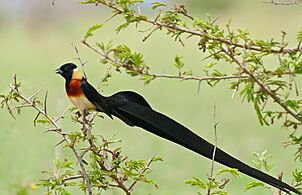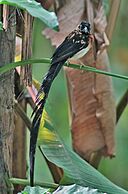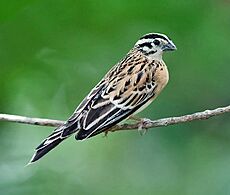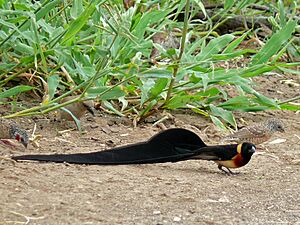Long-tailed paradise whydah facts for kids
Quick facts for kids Long-tailed paradise whydah |
|
|---|---|
 |
|
| Male, Chobe National Park, Botswana | |
| Conservation status | |
| Scientific classification | |
| Genus: |
Vidua
|
| Species: |
paradisaea
|
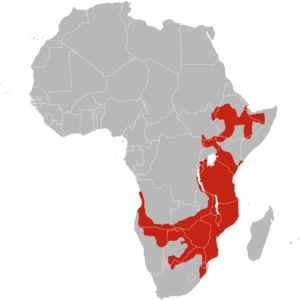 |
|
| resident range | |
| Synonyms | |
|
Emberiza paradisaea Linnaeus, 1758 |
|
The long-tailed paradise whydah (also called the eastern paradise whydah) is a small bird found across Sub-Saharan Africa. It belongs to the family Viduidae and is known for its short, thick bill. These birds mostly eat seeds that have fallen to the ground.
It can be hard to tell male and female whydahs apart, except during breeding season. At this time, male whydahs grow a very long tail. This tail can be three times longer than their body! When it's not breeding season, both males and females look more like regular sparrows with short tails.
Interestingly, male whydahs can copy the songs of other birds. Females often use these songs to choose their mates. However, sometimes females might pick a mate based on how he looks or if there aren't many males singing the right songs. Paradise whydahs are also "brood parasites." This means they lay their eggs in the nests of other songbirds instead of building their own. They don't harm the original eggs in the nest. Overall, these whydahs are not considered endangered.
Contents
About the Long-tailed Paradise Whydah
The long-tailed paradise whydah was first officially described by a Swedish scientist named Carl Linnaeus in 1758. He gave it the scientific name Emberiza paradisaea. Later, it was placed in the group of birds called Vidua.
All birds in the Viduidae family, including the long-tailed paradise whydah, are "brood parasites." This means they lay their eggs in the nests of other bird species. Their main host birds are from the Viduidae family and the Estrildidae family, which are also known as waxbills.
What Do They Look Like?
Different whydah species vary in size, breeding colors, and the songs they use to attract mates. For long-tailed paradise whydahs, it's usually tricky to tell males and females apart. These finches typically grow to about 13 centimeters (about 5 inches) long and weigh around 21 grams (less than an ounce).
Female whydahs usually have a gray bill and grayish-brown feathers with dark streaks. Their under-tail feathers are mostly white. Males, when they are not breeding, look similar. They have mostly brown feathers with black stripes on their head, black parts on their face, and a deeper brown chest with a creamy white belly.
However, during the breeding season, male whydahs transform! They get black heads and backs, a rusty-colored chest, a bright yellow patch on their neck, and a white belly. The most amazing change is their long, black tail feathers. These can grow up to 36 centimeters (about 14 inches) or even longer!
Where Do They Live?
Long-tailed paradise whydahs live in grasslands, savannas, and open woodlands. They prefer areas with bushes and cultivated fields. Most of the time, these whydahs stay away from open water sources.
How Do They Behave?
As mentioned, long-tailed paradise whydahs are known for being brood parasites. They lay their eggs in the nests of other songbirds. They often gather in flocks, both during breeding and non-breeding seasons.
Male whydahs learn to copy the songs of their host birds. Studies show that female whydahs respond more strongly to songs mimicked by males of their own species. Females use this song mimicry to choose a mate, often preferring males raised by the same host species. Sometimes, though, hybridization (mating with a different species) can happen. This might occur if females choose mates based on how they look rather than their song, or if there aren't many males singing the right host songs. Researchers have found that these paradise whydahs often mimic the songs of the Melba Finch.
These paradise whydahs are also granivores, meaning they eat seeds. They mostly feed on small seeds that have ripened and fallen to the ground. To find seeds, they use a special move called "double scratch." They use both feet at almost the same time to scratch the ground, then hop backward to pick up the seeds. They also use their tongue to remove the husks from grass seeds. They roll the seeds back and forth against the roof of their mouth, one at a time, to clean them.
Whydahs and People
For many years, whydahs have been kept as cage birds because of their beautiful songs and colorful breeding feathers. In 1581, a scholar named Michel de Montaigne saw these paradise whydahs in a special bird collection in Florence, Italy. He described them as having "a tail of two long plumes like those of a rooster."
However, paradise whydahs can also be a problem for farmers. For example, in parts of Guinea and Sierra Leone, these birds eat the small seeds of a crop called fonio (also known as "acha" or "hungry rice"). They eat these seeds before farmers can harvest them, which can be a big issue since fonio is often the first food source available to people after the rainy season.
Conservation Status
The long-tailed paradise whydah is found across a very large area. Because of this, it is listed as "Least Concern" on the IUCN Red List of Threatened Species. This means it is not currently considered to be at risk of extinction.



